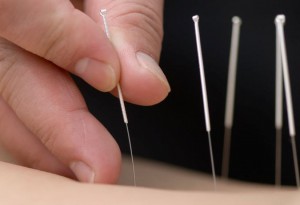Acupuncture
Acupuncture is an alternative medicine in which fine needles are inserted in the skin at specific points along what are considered to be lines of energy (meridians) and is used in the treatment of various physical and mental conditions.
Acupuncture increases the immune response by balancing the flow of life energy throughout the body and alleviates pain. It is a complete system of healing and provides effective treatment for numerous conditions, from the common cold and flus to addiction and chronic fatigue syndrome. It is also effective as an adjunctive treatment for AIDS.
Uses:
A treatment for pain – 50-70 percent of patients receive temporary relief, however some experience long term relief.
- Lower back pain
- Headache and migraine
- Joint pain
- Dental pain
- Insomnia
- Fatigue
- Post-operative pain
- Post-operative nausea and vomiting
- Allergies, including hay fever and eczema
- Depression and anxiety
- Menstrual cramps, carpal tunnel syndrome and fibromyalga
- Chronic pain, including neck and back pain
- Digestive disorders, including irritable bowel syndrome (IBS)
- Infertility and menstrual disorders
- Reduces nausea and vomiting associated with pregnancy, chemotherapy and anesthesia
- Current research is being done to use acupuncture in easing withdrawal from addiction to drugs and alcohol. Another possibility is that acupuncture therapy may speed rehabilitation and limit damage after a paralyzing stroke.
Procedure for Treatment
Tiny needles are inserted at very specific points on the surface of the body. The treatments can vary, depending on the practitioner and style of acupuncture. There are several “schools”, including Chinese, Korean, Japanese and a Westernized version (based on neurology, not Oriented medical philosophy) called trigger-point therapy. Practitioners of Oriental- style acupuncture will usually perform a partial physical examination at the first visit (including extensive pulse-taking and, possibly, examination of the tongue and palpation of the abdomen). They maytake a very detailed medical history, including nutritional habits and other environmental factors. The actual insertion of the needles has been described as feeling like a mosquito bite. After insertion, the needles may be stimulated by twirling them or connecting them to a mild electrical current. This stimulation can cause a tingling or aching sensation referred to as de qi. The needles can be inserted from a fraction of an inch to about one inch deep. They may be withdrawn after a few seconds or kept in place for up to 30 minutes.
Treatment Time:
Allow 20 minutes to 1 hour per session. (The initial visit may take longer)
Treatment Frequency:
This can vary according to your problem. You may start with several treatments per week, then weekly treatments and taper to less often. The duration of therapy can range from a few treatments for acute, temporary problems to regularly scheduled treatments over several months for chronic conditions.
Benefits
Acupuncture has been practiced in China for several thousand years. According to ancient Chinese medical theory, the life force called qi (literal translation of “qi” is breath, air, or gas) flows through the body via 14 invisible channels (called meridians), regulating all physical and mental processes. Opposing forces within the body, called yin and yang, must be balanced to keep qi flowing properly. The meridians are said to run deep within the body’s tissues and organs, that transpire at some 360 places identified as acupuncture points. (also called acupoints) Certain meridians are correlate with specific organs. (such as the bladder or liver) The points all along these meridians, even in the hands or feet, are believed capable of affecting the associated internal organs. Stimulating these points is said to balance and restore the flow of qi. Western scientists proposed that acupuncture may trigger the release of natural pain-killing substances within the body called endorphins, thus reducing pain. It may also alter the body’s output of neurotransmitters (serotonin and norepinephrine) and of inflammation-causing substances such as prostaglandins. Whatever the cause, the pain-relieving effects of acupuncture seem to have a delayed onset; the effects increase slowly and may become more evident after several treatments. They may diminish after acupuncture treatments are ended.
Who Should Avoid This Therapy?
People at risk of easy bruising or excessive bleeding (patients with clotting disorders and those taking a blood thinners) would be prudent to avoid acupuncture. (there is a slight risk of damage to blood vessels) Pregnant women should avoid needle insertion on or near the abdomen.
Side-effects
Acupuncture generally has no inherent side-effects. However, it is important to consult with a skilled and reputable practitioner. Careless application of the technique can present certain hazards. Hepatitis B and serious bacterial infection have been reported due to improperly sterilized needles. A problem that has been controlled by the widespread use of disposable needles. Improperly performed acupuncture can also cause bleeding (if a blood vessel is punctured) or injury to organs, nerves or tissue.
References:
- The Complete Guide To Natural Healing
Note: Consult with a Physician if you are seeking medical remedies. The information is not intended as medical advice. PagansWorld.org is not liable for the misuse of the information listed above.
Thanks for stopping by! Well wishes to you all and have a great day!
Lisa





